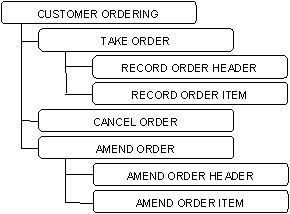

An elementary process is a process that is the smallest unit of business activity of meaning to the business and that, when complete, leaves the business in a consistent state.
The main challenge during process decomposition lies in taking a business perspective on activities that are typically described by users in terms of their current procedures. This perspective is drawn from the business purpose or value to first model the processes that are currently performed and then all the activities that serve the purpose. This identifies a comprehensive set of elementary processes to be performed.
This ideal or improved set of processes are simpler than what is performed. For example, current procedures are grouped into processes that are performed at a single time, as soon as an order is received, or when an order is due to be delivered.
Activities that add value is performed as soon as possible, activities that incur cost, or that do not add value is performed as late as possible ("just in time"), or even omitted altogether.
The project objectives may involve continuous process improvement or radical business process re-engineering. These objectives guide analysts and business managers in the extent of the change that is desirable from the current procedures and processes.
As expected, a process that is described as elementary cannot be further decomposed, at least not into subordinate processes using the Activity Hierarchy Diagram. So, each elementary process is a leaf in the hierarchy. When the activity hierarchy is complete, all leaves are elementary processes.
Identify elementary processes properly because they form the basis for an implementation as parts of a business system.
These guidelines are applied to test each process that is suspected of being elementary to ensure that it falls above or below the elementary process level.
A test for a complete result would check to see that all data actions that must be performed together are performed together. For example, creating an order must include creating at least one order item.
A test for a meaningful result is to ask if the business recognize whether a process has taken place for the entities affected. For example, it is of interest to know that an order has been canceled, but whether the business wants to know that it has been amended need further investigation.
For example, the following illustration shows an Activity Hierarchy Diagram in which all the subordinate activities are processes.

Assume that the fragment of the Entity Relationship Diagram in the following illustration has already been described in the business model.

Assume also that the following descriptions of the business are true:
Is Record Order Header an Elementary Process?
Record Order Header is a process that captures the details of an order entity but none of its order items. Applying the guidelines in this section results in the following observations:
Because it fails to satisfy the first two guidelines, Record Order Header is clearly not an elementary process; neither is Record Order Item. Since the first two guidelines are violated, the process is sub-elementary. An elementary process higher in the hierarchy is identified.
Now consider the process Customer Ordering. Applying the guidelines for identifying elementary processes yields the following results:
Customer Ordering fails to comply with the last guideline, and so is above the level of being an elementary process. Also, Record Order Header is at too low a level. So Take Order is likely to be an elementary process.
Applying the guidelines to Take Order reveals:
Since Take Order complies with every guideline, it is an elementary process.
Consider the Amend Order process. It decomposes in a similar way to Take Order, which was found to be an elementary process. However, based on the underlying set of assumptions, Amend Order Header and Amend Order Item can be executed independently of one another. Given that Amend Order Header and Amend Order Item each produce an amended version of the order, they are elementary processes, each produces meaningful results and leaves the business in a consistent state, even though Record Order Header and Record Order Item were not. This example illustrates that even when decomposition is similar, the designation of elementary processes are different.
The results of this analysis are shown in the following illustration.

The corrected activity hierarchy diagram in the illustration shows that the decomposition of Customer Ordering terminates at the elementary processes Take Order, Cancel Order, Amend Order Header, and Amend Order Item.
Since process decomposition stops at the elementary process level, the sub-elementary processes, Record Order Header, and Record Order Item, have been removed.
|
Copyright © 2014 CA.
All rights reserved.
|
|